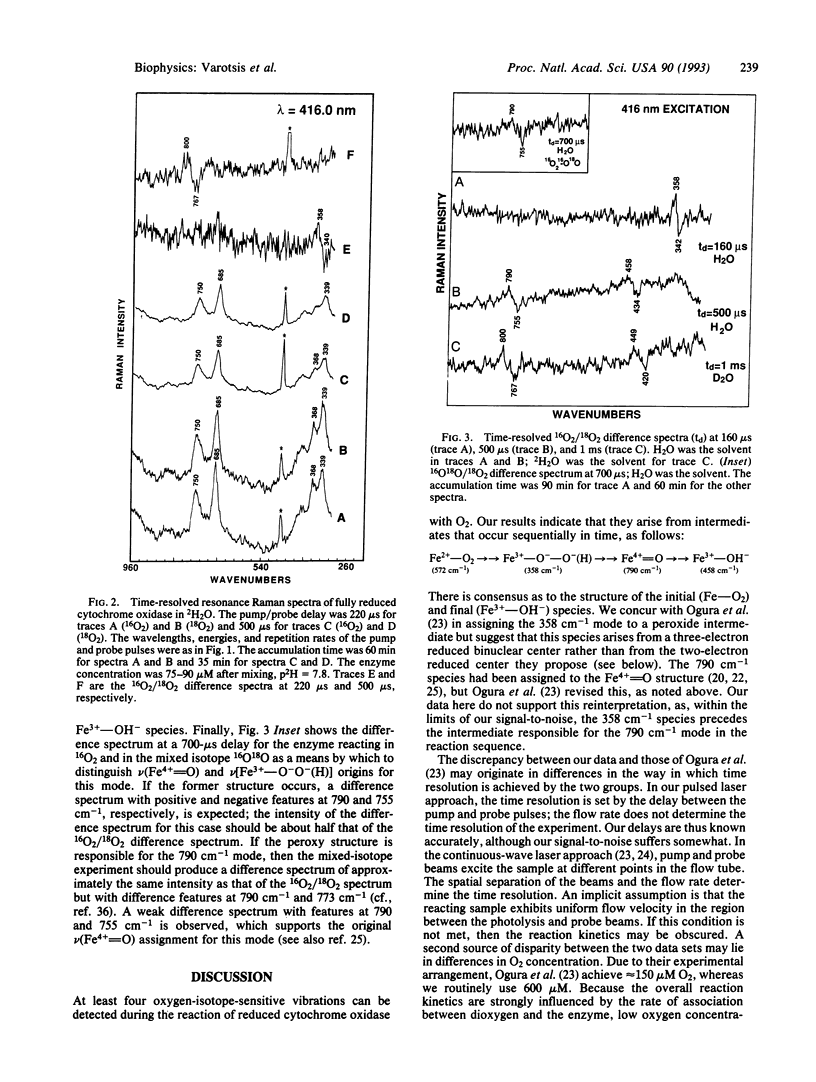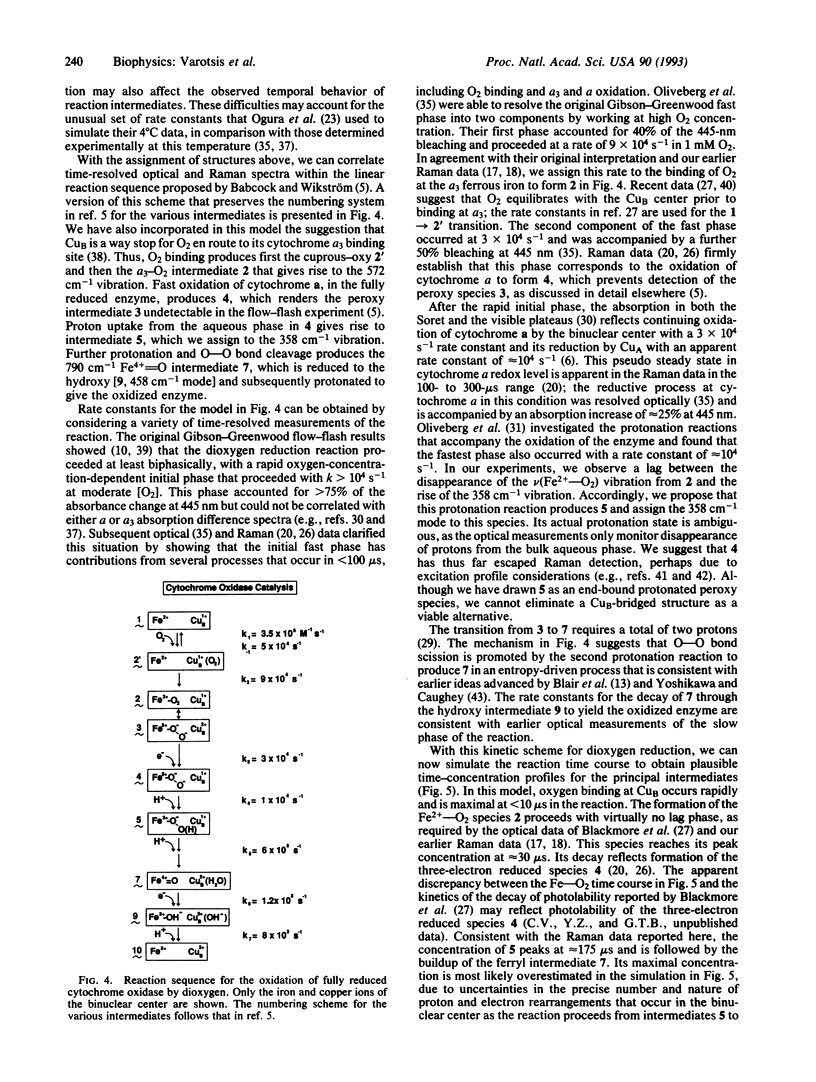Abstract
Time-resolved resonance Raman spectroscopy has been used to study the reduction of dioxygen by the mitochondrial enzyme, cytochrome oxidase. In agreement with earlier reports, Fe(2+)-O2 and Fe(3+)-OH- are detected in the initial and final stages of the reaction, respectively. Two additional intermediates, a peroxy [Fe(3+)-O(-)-O-(H)] and a ferryl (Fe4+ = O), occur transiently. The peroxy species shows an oxygen-isotope-sensitive mode at 358 cm-1 that is assigned as the nu(Fe(3+)-O-) stretching vibration. Our kinetic analysis indicates that the peroxy species we detect occurs upon proton uptake from bulk solution; whether this species bridges to Cu(B) remains uncertain. For the ferryl, nu(Fe(4+) = O) is at 790 cm-1. In our time-resolved spectra, the 358 cm-1 mode appears prior to the 790 cm-1 vibration. By using kinetic parameters deduced from the time-resolved Raman work and from a variety of time-resolved optical studies from other laboratories, we have assigned rate constants to several steps in the linear reaction sequence proposed by G. T. Babcock and M. Wikström [(1992) Nature (London) 356, 301-309]. Simulations of this kinetic scheme provide insight into the temporal behavior of key intermediates in the O2 reduction process. A striking aspect of the reaction time course is that rapid O2-binding and trapping chemistry is followed by a progressive slowing down of succeeding steps in the process, which allows the various transient species to build up to concentrations sufficient for their detection by our time-resolved techniques. Our analysis indicates that this behavior reflects a mechanism in which conditions that allow efficient dioxygen bond cleavage are not inherent to the active site but are only established as the reaction proceeds. This catalytic strategy provides an effective means by which to couple the free energy available in late intermediates in the reduction reaction to the proton-pumping function of the enzyme.
Full text
PDF




Selected References
These references are in PubMed. This may not be the complete list of references from this article.
- Antalis T. M., Palmer G. Kinetic characterization of the interaction between cytochrome oxidase and cytochrome c. J Biol Chem. 1982 Jun 10;257(11):6194–6206. [PubMed] [Google Scholar]
- Babcock G. T., Jean J. M., Johnston L. N., Woodruff W. H., Palmer G. Flow-flash, time-resolved resonance Raman spectroscopy of the oxidation of reduced and of mixed valence cytochrome oxidase by dioxygen. J Inorg Biochem. 1985 Mar-Apr;23(3-4):243–251. doi: 10.1016/0162-0134(85)85031-5. [DOI] [PubMed] [Google Scholar]
- Babcock G. T., Varotsis C., Zhang Y. O2 activation in cytochrome oxidase and in other heme proteins. Biochim Biophys Acta. 1992 Jul 17;1101(2):192–194. [PubMed] [Google Scholar]
- Babcock G. T., Wikström M. Oxygen activation and the conservation of energy in cell respiration. Nature. 1992 Mar 26;356(6367):301–309. doi: 10.1038/356301a0. [DOI] [PubMed] [Google Scholar]
- Blackmore R. S., Greenwood C., Gibson Q. H. Studies of the primary oxygen intermediate in the reaction of fully reduced cytochrome oxidase. J Biol Chem. 1991 Oct 15;266(29):19245–19249. [PubMed] [Google Scholar]
- Chan S. I., Li P. M. Cytochrome c oxidase: understanding nature's design of a proton pump. Biochemistry. 1990 Jan 9;29(1):1–12. doi: 10.1021/bi00453a001. [DOI] [PubMed] [Google Scholar]
- Chance B., Saronio C., Leigh J. S., Jr Functional intermediates in the reaction of membrane-bound cytochrome oxidase with oxygen. J Biol Chem. 1975 Dec 25;250(24):9226–9237. [PubMed] [Google Scholar]
- Clore G. M., Andréasson L. E., Karlsson B., Aasa R., Malmström B. G. Characterization of the low-temperature intermediates of the reaction of fully reduced soluble cytochrome oxidase with oxygen by electron-paramagnetic-resonance and optical spectroscopy. Biochem J. 1980 Jan 1;185(1):139–154. doi: 10.1042/bj1850139. [DOI] [PMC free article] [PubMed] [Google Scholar]
- Dawson J. H. Probing structure-function relations in heme-containing oxygenases and peroxidases. Science. 1988 Apr 22;240(4851):433–439. doi: 10.1126/science.3358128. [DOI] [PubMed] [Google Scholar]
- GIBSON Q. H., GREENWOOD C. Reactions of cytochrome oxidase with oxygen and carbon monoxide. Biochem J. 1963 Mar;86:541–554. doi: 10.1042/bj0860541. [DOI] [PMC free article] [PubMed] [Google Scholar]
- Greenwood C., Gibson Q. H. The reaction of reduced cytochrome C oxidase with oxygen. J Biol Chem. 1967 Apr 25;242(8):1782–1787. [PubMed] [Google Scholar]
- Guengerich F. P. Reactions and significance of cytochrome P-450 enzymes. J Biol Chem. 1991 Jun 5;266(16):10019–10022. [PubMed] [Google Scholar]
- Han S. H., Ching Y. C., Rousseau D. L. Cytochrome c oxidase: decay of the primary oxygen intermediate involves direct electron transfer from cytochrome a. Proc Natl Acad Sci U S A. 1990 Nov;87(21):8408–8412. doi: 10.1073/pnas.87.21.8408. [DOI] [PMC free article] [PubMed] [Google Scholar]
- Han S. W., Ching Y. C., Rousseau D. L. Evidence for a hydroxide intermediate in cytochrome c oxidase. J Biol Chem. 1989 Apr 25;264(12):6604–6607. [PubMed] [Google Scholar]
- Han S. W., Ching Y. C., Rousseau D. L. Primary intermediate in the reaction of oxygen with fully reduced cytochrome c oxidase. Proc Natl Acad Sci U S A. 1990 Apr;87(7):2491–2495. doi: 10.1073/pnas.87.7.2491. [DOI] [PMC free article] [PubMed] [Google Scholar]
- Han S., Ching Y. C., Rousseau D. L. Ferryl and hydroxy intermediates in the reaction of oxygen with reduced cytochrome c oxidase. Nature. 1990 Nov 1;348(6296):89–90. doi: 10.1038/348089a0. [DOI] [PubMed] [Google Scholar]
- Hill B. C., Greenwood C., Nicholls P. Intermediate steps in the reaction of cytochrome oxidase with molecular oxygen. Biochim Biophys Acta. 1986;853(2):91–113. doi: 10.1016/0304-4173(86)90006-6. [DOI] [PubMed] [Google Scholar]
- Hill B. C. The reaction of the electrostatic cytochrome c-cytochrome oxidase complex with oxygen. J Biol Chem. 1991 Feb 5;266(4):2219–2226. [PubMed] [Google Scholar]
- Kobayashi K., Une H., Hayashi K. Electron transfer process in cytochrome oxidase after pulse radiolysis. J Biol Chem. 1989 May 15;264(14):7976–7980. [PubMed] [Google Scholar]
- Ludwig B., Gibson Q. H. Reaction of oxygen with cytochrome c oxidase from Paracoccus denitrificans. J Biol Chem. 1981 Oct 10;256(19):10092–10098. [PubMed] [Google Scholar]
- Oertling W. A., Babcock G. T. Time-resolved and static resonance Raman spectroscopy of horseradish peroxidase intermediates. Biochemistry. 1988 May 3;27(9):3331–3338. doi: 10.1021/bi00409a032. [DOI] [PubMed] [Google Scholar]
- Ogura T., Takahashi S., Shinzawa-Itoh K., Yoshikawa S., Kitagawa T. Observation of the Fe4+ = O stretching Raman band for cytochrome oxidase compound B at ambient temperature. J Biol Chem. 1990 Sep 5;265(25):14721–14723. [PubMed] [Google Scholar]
- Oliveberg M., Brzezinski P., Malmström B. G. The effect of pH and temperature on the reaction of fully reduced and mixed-valence cytochrome c oxidase with dioxygen. Biochim Biophys Acta. 1989 Dec 7;977(3):322–328. doi: 10.1016/s0005-2728(89)80087-8. [DOI] [PubMed] [Google Scholar]
- Oliveberg M., Hallén S., Nilsson T. Uptake and release of protons during the reaction between cytochrome c oxidase and molecular oxygen: a flow-flash investigation. Biochemistry. 1991 Jan 15;30(2):436–440. doi: 10.1021/bi00216a019. [DOI] [PubMed] [Google Scholar]
- Oliveberg M., Malmström B. G. Reaction of dioxygen with cytochrome c oxidase reduced to different degrees: indications of a transient dioxygen complex with copper-B. Biochemistry. 1992 Apr 14;31(14):3560–3563. doi: 10.1021/bi00129a002. [DOI] [PubMed] [Google Scholar]
- Orii Y. Intermediates in the reaction of reduced cytochrome oxidase with dioxygen. Ann N Y Acad Sci. 1988;550:105–117. doi: 10.1111/j.1749-6632.1988.tb35327.x. [DOI] [PubMed] [Google Scholar]
- Saraste M. Structural features of cytochrome oxidase. Q Rev Biophys. 1990 Nov;23(4):331–366. doi: 10.1017/s0033583500005588. [DOI] [PubMed] [Google Scholar]
- Varotsis C., Babcock G. T. Appearance of the v(FeIV = O) vibration from a ferryl-oxo intermediate in the cytochrome oxidase/dioxygen reaction. Biochemistry. 1990 Aug 14;29(32):7357–7362. doi: 10.1021/bi00484a001. [DOI] [PubMed] [Google Scholar]
- Varotsis C., Woodruff W. H., Babcock G. T. Direct detection of a dioxygen adduct of cytochrome a3 in the mixed valence cytochrome oxidase/dioxygen reaction. J Biol Chem. 1990 Jul 5;265(19):11131–11136. [PubMed] [Google Scholar]
- Wikström M. Energy-dependent reversal of the cytochrome oxidase reaction. Proc Natl Acad Sci U S A. 1981 Jul;78(7):4051–4054. doi: 10.1073/pnas.78.7.4051. [DOI] [PMC free article] [PubMed] [Google Scholar]
- Wikström M. Identification of the electron transfers in cytochrome oxidase that are coupled to proton-pumping. Nature. 1989 Apr 27;338(6218):776–778. doi: 10.1038/338776a0. [DOI] [PubMed] [Google Scholar]
- Woodruff W. H., Einarsdóttir O., Dyer R. B., Bagley K. A., Palmer G., Atherton S. J., Goldbeck R. A., Dawes T. D., Kliger D. S. Nature and functional implications of the cytochrome a3 transients after photodissociation of CO-cytochrome oxidase. Proc Natl Acad Sci U S A. 1991 Mar 15;88(6):2588–2592. doi: 10.1073/pnas.88.6.2588. [DOI] [PMC free article] [PubMed] [Google Scholar]
- Yoshikawa S., Caughey W. S. Infrared evidence of cyanide binding to iron and copper sites in bovine heart cytochrome c oxidase. Implications regarding oxygen reduction. J Biol Chem. 1990 May 15;265(14):7945–7958. [PubMed] [Google Scholar]


